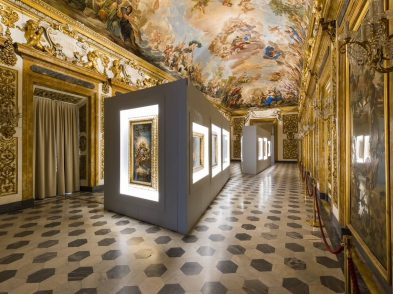Although Florence is a cultural capital with few equals on the planet, its immense historical legacy has tended to overshadow the place that contemporary art occupies in the city. Yet as recently as the 1960s and 70s, Florence was acknowledged as an avant-garde centre for visual arts and architecture and a focal point of experimental activity. The Feltrinelli bookshop on via Cavour hosted radical events involving poets, critics and artists, and dozens of galleries presented new art around the city. Times have changed and today history holds sway. But two striking exhibitions remind visitors that radical modern ideas still find space on the walls of its galleries.
Gianfranco Baruchello is an artist who specialises in making non-stories. That is, although his meticulously drawn or assembled images teem with tiny figures, small objects and writing in several languages, they refuse to add up to a coherent narrative.
Baruchello’s career, nurtured early on by formative friendships with Marcel Duchamp and John Cage, has never been limited to art’s traditional boundaries. The subject of a major retrospective at Rome’s National Gallery of Modern Art in 2011–12, his work has engaged the mind as well as the imagination for over five decades, touching on the real world and, with its fevered connections and ever-changing repertoire of symbols, exploring the productive subconscious.

G. Baruchello, Lo stato presente delle cose
Perhaps imitating our overstimulated brains, his outline drawings hoard information of debatable value that may one day become useful. Compositions invariably branch out in many directions simultaneously, like a tree in rapid growth. For example, one large square painting is called Eros ecumenico postindustriale, an indecipherable title that brings together in just three words diverse ideas spanning myth, human attraction, church relations and an era in which services and research have supplanted manufacturing.
The painting appears as disarming as its title. The voluminous white surface harbours numerous miniature drawings, variously coloured to stand out from the background void against which they seem to hover. By looking closely we pick out industrious pockets of immense detail, among them sections of neatly dismantled rocket; human figures in different poses, many humorous; reassembled pieces of shattered tile; several gasmasks; and tiny illegible inscriptions that may be instructions. Although these particles are laid out in a balanced fashion, like a kit awaiting assembly, attempts at connecting them quickly appear futile. Rather than completing a single story, Baruchello starts hundreds that may have no ending. Such images of mental ferment and creativity soon strike a familiar chord.
This painting, made in 1970, appears in Baruchello’s subtly triumphant show at Galleria Il Ponte. Alongside work painted on canvas, aluminium and transparent plexiglass are small, glass-fronted boxes in which pictorial space is extended into three dimensions. Filled with neatly placed objects made and found, they resemble stage sets or nests of concentrated thought. All date from 1962 to 1978, the years when this self-taught artist’s distinct and individual practice reached its maturity.
For Baruchello, still active at almost 90, is a painter and object maker who is also a filmmaker, writer, collagist, inventor of useless machines, philosopher and former businessman and farmer. These activities have shaped his generous attitude to the nature of art, so that even existing events and artefacts, so-called ready mades, are legitimate materials. Indeed, the banality of modern society becomes potent material for his enquiry into the dubious unpredictability of existence. ‘I consider the error,’ he once wrote, ‘a fundamental evolutionary fact.’
Galleria Il Ponte is among a handful of locations with an accent on modernity that should appear on cultural itineraries. Based in via di Mezzo since 1977, its exhibition programme features prominent artists, such as Giuseppe Chiari, Jannis Kounellis, Paolo Icaro and Mauro Staccioli, who are among the masters of Italy’s post-war renaissance, a period far richer and more varied in achievement than foreigners and native Italians often realise.
Moreover, many artists with international reputations continue to work in Florence. As well as maintaining their individual careers, Maurizio Nannucci, Paolo Masi and Massimo Bartolini—who works on the coast—are members of the collective running BASE, the not-for-profit exhibition space in San Niccolò that for 15 years has invited artists from around the world to create temporary new work or new configurations of existing work specifically suited to the architecture of its two small rooms.

D. Tremlett, Due pareti
British artist David Tremlett, whose works were recently exhibited at BASE, made drawings in pastel on the walls, one filling a round-arched end wall and the other surrounding a window overlooking the street. These positions guided the artist’s choice of emblematic forms, bringing to his mind wall surfaces, colours and patterns remembered from other buildings, countries, cultures and climates.
As a result, Tremlett both alluded to Florence, the context of its streetscape and heritage of murals, and detached the space from its place and moment, imaginatively importing new associations into an experience coloured by contrasting impressions of time. For, on one hand, the decoration appeared historic, even ancient, while on the other, it felt as transitory as light and shadow. Made with pastel, a fragile powder light enough to blow away, the installation exuded the calm of permanence.
1962–1978 Twenty-four Artworksby Gianfranco Baruchello
Until January 31, 2014 – Galleria Il Ponte, via di Mezzo 42/b, Florence
Base/Progetti per l’arte
via San Niccolò 18r, Florence






